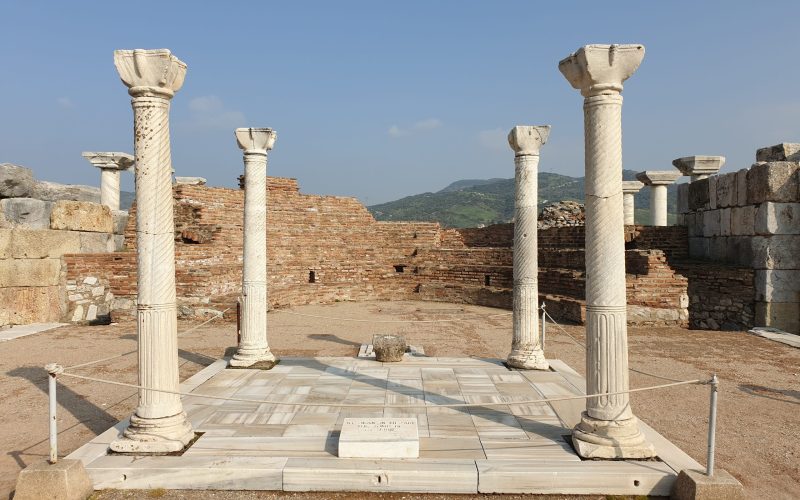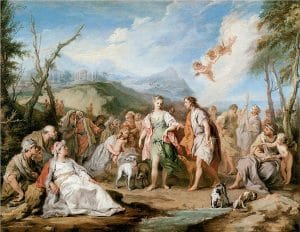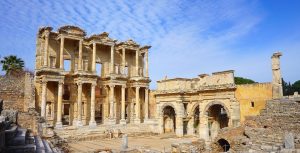St. Paul in Ephesus – Apostle Paul
Paul starts his mission in Antioch the provincial capital of Syria. His followers were the first people to be called Christians, and he then kept moving through all the big cities of the
region. Seeking the places where the old religions are most powerful. People preach his message in the shadow of the Temple of Artemis. It is one of the wonders of the ancient world
and the biggest pagan temple on the planet.
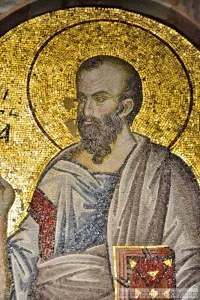
In 52 AD, St Paul comes to Ephesus, the fourth largest city in the ancient world. He is just one of tens of thousands of pilgrims visiting the city, most have come to venerate the goddess Artemis. Artemis was the goddess of the hunt. She was also the protector of virgins and we know that during the yearly festivals, this was a time when young unmarried women would find their spouses. Artemis was one of the most important gods in Greek and Roman religion, and here she had a shrine to match her status.
The Temple of Artemis was known far and wide. Its image was molded on the coins, that circulated the region. This was one of the seven wonders of the world and in Paul’s time the largest temple in existence. As a magnet for pagan pilgrims, it played a key role in Paul’s plan. Ephesus became a wonderful base for him, because the Temple of Artemis was here, and used it for benefit.
Because many people came into the city to participate in the various festivities were in the audience for him to preach the gospel, too. Are investigators will reconstruct the Temple of Artemis as Paul would have seen it? The evidence suggests that the people of Ephesus used revelation area construction techniques. But all that remains today are a few marble blocks recovered from beneath 20 feet of silt. In their desire to honor their goddess.
The temple builders and engineers set themselves a challenging task. the decision was made to build the temple entirely from marble, and the nearest source of marble lay 8 miles away. It all had to be transported back to the construction site. An estimated fifty-one thousand tons of marble were needed. The Ephesians didn’t do the hard work themselves they delegated to slaves and criminals. and common punishment for the crime was to be sentenced to work in the quarries. You were expected to live too long and you probably didn’t.
Once they carved out the blocks they still had to get them to the temple construction site. In the 21st century, quarrymen relied on heavy machinery, a few hundred yards from the ancient quarry, gray marble is still being extracted from the same site. The average block is 13 tons about the same size as the blocks used to build the Temple of Artemis. Today, machines make it look easy. When the temples were built shared manpower. However, the temple architects used all their ingenuity to speed up the process. They invented a method that would make them better stone movers than even the Egyptians.

They turned the square blocks into wheels, wooden cradles were built around the cut rock. So They could easily be ruled the eight miles into town. Once they had the raw materials they got set about building one of the greatest temples the world has ever seen. In its heyday, it would attract more pilgrims and the Temple of the Jews in Jerusalem. Today the site where it once stood is a flooded Marsh. It is hard to imagine why such a huge temple would be constructed here, on a piece of land no modern builder would touch.
The Roman historian Pliny claims the marshy ground was chosen as a precaution against frequent earthquakes, it would cushion the tremors. Another theory is that a meteor landed here, the Ancients thought it was a god sent from heaven and constructed their temple around it. Either way, the location presented the builders with a serious problem. How to construct what would be one of the wonders of the world in a swamp.
They started by creating a dry base, trading down a layer of charcoal then covering it with sheep fleece to prevent water from rising. Slip blocks were put on top. The floor of slate and marble was built 8 feet high to stay above the water level. It spanned an area of 255 feet wide and 425 feet long. This dirty platform supported a forest of columns.
This one is 45 feet high but plenty reveals that the originals were a massive 60 feet, six stories tall, to achieve this ambitious engineering task the architect used scaffolding they assembled the columns from a series of stock drums each weighing more than 8 tons a column consisted of a round 30 drum and once assembled they were fluid with a hammer and chisel this was done an incredible 127 time.
It took 120 years to complete the temple. We can now bring to life this incredible part of St. Paul’s Lost World astonishing building that was bigger than anything that had gone before it was the focal point of huge activity all centered around the cult of the goddess and the awning on the roof bathed her statue in light, and the cult of Artemis was no means the city’s only religion.
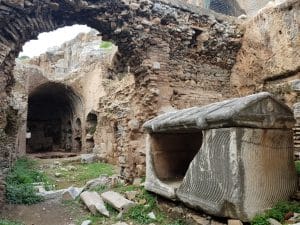
The Romans believed in the many gods and they tolerated the traditional beliefs of the people they conquered. So, at first, Paul and his new religion are well-received, at a few miles from the temple in the city center. Paul discovered something that would allow him to deliver his message to an audience of unprecedented size. 25.000 people came to the theater for games and protests. The city’s theater also built from white marble was undergoing expansion while Paul was in the city. 459 feet across containing 66 rows of seats it was once the largest theater in the country. Paul overcomes here and addresses the biggest audiences of his life.
This is wider and the further up you go there narrower and its concave shape helps to maintain the sound in the theater. But the theater wasn’t designed simply for speeches from plays the partition. That shield in the front row indicates that Paul shared his stage with more dangerous entertainment. The recent discovery of a dedicated graveyard in Ephesus, confirms that this theater was an arena where gladiators fought. These immensely popular contests drew large audiences as far as Paul was concerned.
The gladiator games attracted even more people to hear his message. What separated Saint Paul from Jesus’s other disciples is that he didn’t just target Jews he aimed to convert people of all faiths, his methods caused Christianity to become a worldwide religion. Ultimately they would bring about the downfall of the Roman Empire, and yet it was the Romans engineering skills that gave Saint Paul the opportunity he needed.
St. Paul lived in preached in the city of Ephesus part of modern-day Turkey for two and a half years the largest city in Roman Asia with an open-minded cosmopolitan population. It was the ideal place to seek new converse. Archaeologist Julian Bennetts discovered that the way the Romans built their towns gave Paul a unique chance to bring huge numbers of people to Christianity. But he also finds that this city had its eye fixed on more worldly pursuits in theology and a new religion.
Paul was in a city with a reputation for pleasure-seeking. dominated society when the young man would not marry until he was dismissed from the city and would have had several brothels right in the center of town. early archaeologists found it an intriguing signpost a foot and a heart. It was called the first advertisement about brothels in the world for many years. In the 19th century, several oil lamps with scenes of erotic art on them and also an inscription was found referring to two young people.
Prostitution was an important source of income for the Roman administration. Even notice, prostitutes paid the tax to the city and to the government tax and they have to pay this tax every month. but it wasn’t just about the pleasure the fundamental challenge for the town administrators was providing vital amenities for over 200,000 people. The most important was running water, the city source was eight miles away. Requires an extraordinary feat of engineering. Polio aqueduct was one of them.
Whatever their motive the private individuals who pay for projects like this, brought service to the city Polio’s aqueduct carried vital water supplies into Ephesus where he entered an elaborate cistern. Pipes ran in a network down the hill. There were 100 gallons per day for each Ephesian, comparable to the provision made in most modern cities. Paul and most other citizens got their water from communal fountains. But some buildings were supplied directly, one was the bathhouse.
The Roman baths with a focal point of the city’s social life, here the Ephesians discuss politics, philosophy, and Paul’s religious ideas. Christianity spread by word of mouth and it was from places like this that Paul’s message began to pass to a wider audience. The bath houses workplaces equipped with what was then high technology including an underfloor heating system called a hypocaust. Hot air flooded under floor space spreading up the walls to heat the room from all sides. Hot water was piped into the bath.
The dirty water from the bathhouse was put to good use if left out waste from other buildings, and just next door is one of the most important facilities found in any large Roman city. Paul has used these public restrooms, the upper classes have the privacy of their luxury homes. Today the remains of these lavish houses are protected in a climate-controlled shelter. St Paul would have seen them being built and furnished an exotic marble, brought from across the Roman Empire to advertise their owner’s wealth.;
Each house had a private bathroom, constantly flushed by the continuous flow of the aqueduct system. They had different-sized water pipes and may calculate to tax you paid by the size. The wealthiest households could even afford an early form of air conditioning and walls of water. They need water for washing and cleaning but it helps to cool down so, especially in the middle of the summer. The Ephesian ruling classes enjoyed a high quality of life and suddenly Paul threatened to disrupt not only did he undermine their pagan beliefs but with it, he damaged the city’s most important trade. Religion was big business in this Ephesus. Its market fed off pilgrims to the temple.
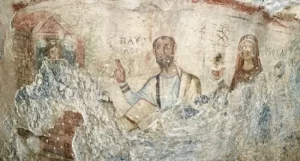
Silver statuettes of the goddess Artemis sold his charms and brought investment revenue. But with the arrival of Christianity minted people were turning their backs on Ephesus. 25,000 people gathered in the great theatre to hear a silversmith called Demetrius speak. He told them that Paul was not only insulting their goddess but also threatening their main source of income. He stirred the crowd to the point where an anti-Christian riot erupted. Tradition has it that to appease the angry mob Paul was thrown into prison.
It’s thought that was where he would write some of the letters that would make up so much of the New Testament. On his release, he was told to leave Ephesus, but his new religion had already taken hold, and the city was becoming a city of Christians. And the silversmith Demetrius was right, the city of Ephesus declined with the cult of Artemis. it was the beginning of a long slow collapse that would see the temple fall into ruin. Paul moved on, his message would have an equally powerful effect elsewhere. It would reach the very furthest parts of the Roman Empire, transforming every community it touched.
(NIW) Act 19 Bible;
St. Paul in Ephesus
- 1 While Apollos was at Corinth, Paul took the road through the interior and arrived at Ephesus. There he found some disciples
- 2 and asked them, “Did you receive the Holy Spirit when you believed?” They answered, “No, we have not even heard that there is a Holy Spirit.”
- 3 So Paul asked, “Then what baptism did you receive?” “John’s baptism,” they replied.
- 4 Paul said, “John’s baptism was a baptism of repentance. He told the people to believe in the one coming after him, that is, in Jesus.”
- 5 On hearing this, they were baptized in the name of the Lord Jesus.
- 6 When Paul placed his hands on them, the Holy Spirit came on them, and they spoke in tongues and prophesied.
- 7 There were about twelve men in all.
- 8 Paul entered the synagogue and spoke boldly there for three months, arguing persuasively about the kingdom of God.
- 9 But some of them became obstinate; they refused to believe and publicly maligned the Way. So Paul left them. He took the disciples with him and had discussions daily in the lecture hall of Tyrannus.
- 10 This went on for two years so that all the Jews and Greeks who lived in the province of Asia heard the word of the Lord.
- 11 God did extraordinary miracles through Paul,
- 12 so that even handkerchiefs and aprons that had touched him were taken to the sick and their illnesses were cured and the evil spirits left them.
- 13 Some Jews who went around driving out evil spirits tried to invoke the name of the Lord Jesus over those who were demon-possessed. They would say, “In the name of the Jesus
whom Paul preaches, I command you to come out.” - 14 Seven sons of Sceva, a Jewish chief priest, were doing this.
- 15 One day the evil spirit answered them, “Jesus I know, and Paul I know about, but who are you?”
- 16 Then the man who had the evil spirit jumped on them and overpowered them all. He gave them such a beating that they ran out of the house naked and bleeding.
- 17 When this became known to the Jews and Greeks living in Ephesus, they were all seized with fear, and the name of the Lord Jesus was held in high honor.
- 18 Many of those who believed now came and openly confessed what they had done.
- 19 A number who had practiced sorcery brought their scrolls together and burned them publicly. When they calculated the value of the scrolls, the total came to fifty thousand drachmas.
- 20 In this way the word of the Lord spread widely and grew in power.
- 21 After all this had happened, Paul decided to go to Jerusalem, passing through Macedonia and Achaia. “After I have been there,” he said, “I must visit Rome also.”
- 22 He sent two of his helpers, Timothy and Erastus, to Macedonia, while he stayed in the province of Asia a little longer. The Riot in Ephesus
- 23 About that time there arose a great disturbance about the way.
- 24 A silversmith named Demetrius, who made silver shrines of Artemis, brought in a lot of business for the craftsmen there.
- 25 He called them together, along with the workers in related trades, and said: “You know, my friends, that we receive a good income from this business.
- 26 And you see and hear how this fellow Paul has convinced and led astray large numbers of people here in Ephesus and in practically the whole province of Asia. He says that gods made by human hands are no gods at all.
- 27 There is danger not only that our trade will lose its good name, but also that the temple of the great goddess Artemis will be discredited; and the goddess herself, who is worshiped throughout the province of Asia and the world, will be robbed of her divine majesty.”
- 28 When they heard this, they were furious and began shouting: “Great is Artemis of the Ephesians!”
- 29 Soon the whole city was in an uproar. The people seized Gaius and Aristarchus, Paul’s traveling companions from Macedonia, and all of them rushed into the theater together.
- 30 Paul wanted to appear before the crowd, but the disciples would not let him.
- 31 Even some of the officials of the province, friends of Paul, sent him a message begging him not to venture into the theater.
- 32 The assembly was in confusion: Some were shouting one thing, some another. Most of the people did not even know why they were there.
- 33 The Jews in the crowd pushed Alexander to the front, and they shouted instructions to him. He motioned for silence to make a defense before the people.
- 34 But when they realized he was a Jew, they all shouted in unison for about two hours: “Great is Artemis of the Ephesians!”
- 35 The city clerk quieted the crowd and said: “Fellow Ephesians, doesn’t all the world know that the city of Ephesus is the guardian of the temple of the great Artemis and her image,
which fell from heaven? - 36 Therefore, since these facts are undeniable, you ought to calm down and not do anything rash.
- 37 You have brought these men here, though they have neither robbed temples nor blasphemed our goddess.
- 38 If, then, Demetrius and his fellow craftsmen have a grievance against anybody, the courts are open and there are proconsuls. They can press charges.
- 39 If there is anything further you want to bring up, it must be settled in a legal assembly.
- 40 As it is, we are in danger of being charged with rioting because of what happened today. In that case, we would not be able to account for this commotion, since there is no reason for it.”
- 41 After he had said this, he dismissed the assembly.
Daily life in Ephesus – About Ephesus
- Ephesus Gods and Goddess
- About Ephesus history
- Festivals in Ephesus ceremony and procession
- Ephesus city management
- Sex life in Ephesus
- Burial in Ephesus
- How was childhood in the ancient city of Ephesus in Greek and Roman times?
- What did women do for their beauty in ancient Ephesus?
- How was the Marriage? Get married in daily life in Ephesus
- Ancient Ephesus food beverage cuisine and meal
- Gladiators in Ephesus
- Clothing and fashion in Ancient Ephesus
- Ephesus The Comedy of Errors – Shakespeare
- St. Paul in Ephesus
- Virgin Mother Mary in Ephesus
- Ancient Ephesus Marbles
- Ancient Ephesus History
- Slavery in Ephesus
- Ephesus Council – Biblical Ephesus
- Ephesus Temple, Ephesus Offerings Votives

